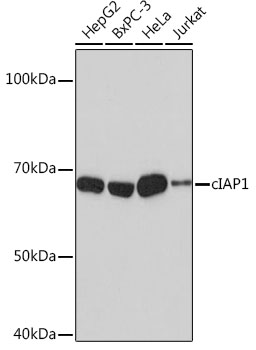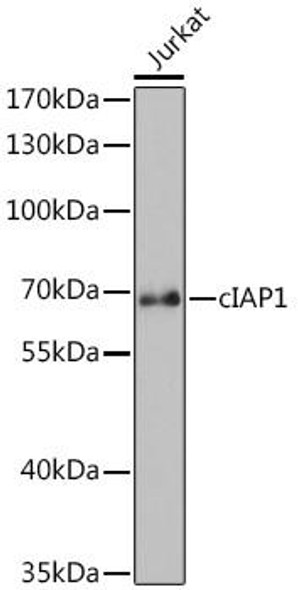Cell Death Antibodies 2
Anti-cIAP1 Antibody (CAB19688)
- SKU:
- CAB19688
- Product Type:
- Antibody
- Reactivity:
- Human
- Reactivity:
- Mouse
- Reactivity:
- Rat
- Host Species:
- Rabbit
- Isotype:
- IgG
- Research Area:
- Cell Death
Description
| Antibody Name: | Anti-cIAP1 Antibody |
| Antibody SKU: | CAB19688 |
| Antibody Size: | 20uL, 50uL, 100uL |
| Application: | WB IHC |
| Reactivity: | Human, Mouse, Rat |
| Host Species: | Rabbit |
| Immunogen: | A synthesized peptide derived from human cIAP1. |
| Application: | WB IHC |
| Recommended Dilution: | WB 1:500 - 1:2000 IHC 1:50 - 1:200 |
| Reactivity: | Human, Mouse, Rat |
| Positive Samples: | HepG2, BxPC-3, HeLa, Jurkat |
| Immunogen: | A synthesized peptide derived from human cIAP1. |
| Purification Method: | Affinity purification |
| Storage Buffer: | Store at -20°C. Avoid freeze / thaw cycles. Buffer: PBS with 0.02% sodium azide, 0.05% BSA, 50% glycerol, pH7.3. |
| Isotype: | IgG |
| Sequence: | Email for sequence |
| Gene ID: | 329 |
| Uniprot: | Q13490 |
| Cellular Location: | Cytoplasm, Nucleus |
| Calculated MW: | 70kDa |
| Observed MW: | 68KDa |
| Synonyms: | API1, HIAP2, Hiap-2, MIHB, RNF48, c-IAP1, cIAP1, BIRC2 |
| Background: | The protein encoded by this gene is a member of a family of proteins that inhibits apoptosis by binding to tumor necrosis factor receptor-associated factors TRAF1 and TRAF2, probably by interfering with activation of ICE-like proteases. This encoded protein inhibits apoptosis induced by serum deprivation and menadione, a potent inducer of free radicals. Alternatively spliced transcript variants encoding different isoforms have been found for this gene. [provided by RefSeq, Jan 2012] |
| UniProt Protein Function: | BIRC2: Multi-functional protein which regulates not only caspases and apoptosis, but also modulates inflammatory signaling and immunity, mitogenic kinase signaling, and cell proliferation, as well as cell invasion and metastasis. Acts as an E3 ubiquitin- protein ligase regulating NF-kappa-B signaling and regulates both canonical and non-canonical NF-kappa-B signaling by acting in opposite directions: acts as a positive regulator of the canonical pathway and suppresses constitutive activation of non-canonical NF-kappa-B signaling. The target proteins for its E3 ubiquitin- protein ligase activity include: RIPK1, RIPK2, RIPK3, RIPK4, CASP3, CASP7, CASP8, TRAF2, DIABLO/SMAC, MAP3K14/NIK, MAP3K5/ASK1, IKBKG/NEMO and MXD1/MAD1. Can also function as an E3 ubiquitin- protein ligase of the NEDD8 conjugation pathway, targeting effector caspases for neddylation and inactivation. Acts as an important regulator of innate immune signaling via regulation of Toll-like receptors (TLRs), Nodlike receptors (NLRs) and RIG-I like receptors (RLRs), collectively referred to as pattern recognition receptors (PRRs). Protects cells from spontaneous formation of the ripoptosome, a large multi-protein complex that has the capability to kill cancer cells in a caspase-dependent and caspase-independent manner. Suppresses ripoptosome formation by ubiquitinating RIPK1 and CASP8. Can stimulate the transcriptional activity of E2F1. Plays a role in the modulation of the cell cycle. Interacts with DIABLO/SMAC and with PRSS25; these interactions inhibit apoptotic suppressor activity. Interacts with CASP9. Interacts (via BIR domains) with TRAF2. Interacts with E2F1, RIPK1, RIPK2, RIPK3, RIPK4, BIRC5/survivin and USP19. Present in many fetal and adult tissues. Mainly expressed in adult skeletal muscle, thymus, testis, ovary, and pancreas, low or absent in brain and peripheral blood leukocytes. The CARD domain inhibits the activation of E3 ubiquitin ligase activity by preventing RING domain dimerization and E2 ubiquitin donor binding and activation. The CARD domain- mediated autoinhibition of the E3 ubiquitin-protein ligase activity suppresses cell proliferation and migration. USP19 regulates the stability of BIRC2/c-IAP1 by preventing its ubiquitination. Belongs to the IAP family. |
| UniProt Protein Details: | Protein type:Ubiquitin ligase; EC 6.3.2.-; Ubiquitin conjugating system; Ligase Chromosomal Location of Human Ortholog: 11q22 Cellular Component: XY body; internal side of plasma membrane; spindle microtubule; cytoplasm; nucleus; cytosol; lipid raft Molecular Function:protein binding; zinc ion binding; caspase inhibitor activity; transcription coactivator activity; ubiquitin-protein ligase activity; protein N-terminus binding; ligase activity Biological Process: proteasomal ubiquitin-dependent protein catabolic process; regulation of toll-like receptor signaling pathway; positive regulation of I-kappaB kinase/NF-kappaB cascade; protein polyubiquitination; response to cAMP; transcription, DNA-dependent; apoptosis; regulation of cell cycle; protein heterooligomerization; MyD88-independent toll-like receptor signaling pathway; toll-like receptor 3 signaling pathway; regulation of innate immune response; regulation of cell proliferation; regulation of apoptosis; response to ethanol; cell surface receptor linked signal transduction; regulation of transcription, DNA-dependent; regulation of cell differentiation; regulation of inflammatory response; response to hypoxia; toll-like receptor signaling pathway; innate immune response; toll-like receptor 4 signaling pathway; placenta development; cell structure disassembly during apoptosis; negative regulation of apoptosis |
| NCBI Summary: | The protein encoded by this gene is a member of a family of proteins that inhibits apoptosis by binding to tumor necrosis factor receptor-associated factors TRAF1 and TRAF2, probably by interfering with activation of ICE-like proteases. This encoded protein inhibits apoptosis induced by serum deprivation and menadione, a potent inducer of free radicals. Alternatively spliced transcript variants encoding different isoforms have been found for this gene. [provided by RefSeq, Jan 2012] |
| UniProt Code: | Q13490 |
| NCBI GenInfo Identifier: | 2497238 |
| NCBI Gene ID: | 329 |
| NCBI Accession: | Q13490.2 |
| UniProt Secondary Accession: | Q13490,Q16516, Q4TTG0, B4E026, |
| UniProt Related Accession: | Q13490 |
| Molecular Weight: | 618 |
| NCBI Full Name: | Baculoviral IAP repeat-containing protein 2 |
| NCBI Synonym Full Names: | baculoviral IAP repeat containing 2 |
| NCBI Official Symbol: | BIRC2 |
| NCBI Official Synonym Symbols: | API1; MIHB; HIAP2; RNF48; cIAP1; Hiap-2; c-IAP1 |
| NCBI Protein Information: | baculoviral IAP repeat-containing protein 2; IAP-2; IAP homolog B; apoptosis inhibitor 1; RING finger protein 48; inhibitor of apoptosis protein 2; baculoviral IAP repeat-containing 2; NFR2-TRAF signalling complex protein; TNFR2-TRAF-signaling complex protein 2 |
| UniProt Protein Name: | Baculoviral IAP repeat-containing protein 2 |
| UniProt Synonym Protein Names: | C-IAP1; IAP homolog B; Inhibitor of apoptosis protein 2; IAP-2; hIAP-2; hIAP2; RING finger protein 48; TNFR2-TRAF-signaling complex protein 2 |
| Protein Family: | Baculoviral IAP repeat-containing protein |
| UniProt Gene Name: | BIRC2 |
| UniProt Entry Name: | BIRC2_HUMAN |







